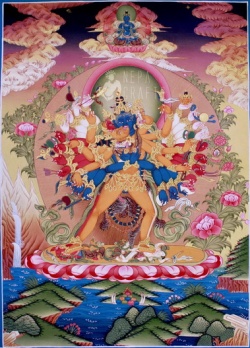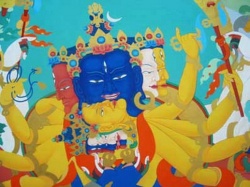Difference between revisions of "Kalachakra (Dukyi Khorlo) & Vishvamata"
(Created page with " <poem> Twelve months after his parinirvana ( yongsu nya nganla dapa ), Shakyamuni is thought to have manifested as Kalachakra in Sri Dhanyakataka...") |
|||
| (One intermediate revision by the same user not shown) | |||
| Line 1: | Line 1: | ||
| − | + | [[File:62.Kalacakra.jpg|thumb|250px|]][[File:Glogakra.jpg|thumb|250px|]] | |
<poem> | <poem> | ||
Twelve months after his [[parinirvana]] ( [[yongsu nya nganla dapa]] ), [[Shakyamuni]] is [[thought]] to have [[manifested]] as [[Kalachakra]] in [[Sri Dhanyakataka]] , [[India]] to give the [[initiation]] of [[Kalachakra Tantra]] ([[Gyud]]). In English, [[Kalachakra]] translates as "[[wheel of time]]", a [[universal]] [[philosophy]] of [[Buddhism]] and a complex and [[esoteric]] {{Wiki|concept}} of the [[Tantrayana]] ([[Dorje Thegpa]]). | Twelve months after his [[parinirvana]] ( [[yongsu nya nganla dapa]] ), [[Shakyamuni]] is [[thought]] to have [[manifested]] as [[Kalachakra]] in [[Sri Dhanyakataka]] , [[India]] to give the [[initiation]] of [[Kalachakra Tantra]] ([[Gyud]]). In English, [[Kalachakra]] translates as "[[wheel of time]]", a [[universal]] [[philosophy]] of [[Buddhism]] and a complex and [[esoteric]] {{Wiki|concept}} of the [[Tantrayana]] ([[Dorje Thegpa]]). | ||
| − | [[Kalachakra]] resides in [[Shambala]], a fascinating [[mythological]] city. It is [[thought]] to have been a {{Wiki|kingdom}} of the distant past that disappeared into a [[celestial realm]] after the [[complete enlightenment]] of the {{Wiki|society}}. It is believed that after a dark and barbaric period the [[kings]] of [[Shambala]] will return to save [[humanity]]. The [[dharma]] will spread and all of [[humanity]] will [[experience]] a great impetus toward [[enlightenment]]. There are parallels between this story and the prediction of [[Maitreya]], the [[Buddha of the future]] who presently resides in [[Tushita heaven]] ([[Ganden]]). | + | [[Kalachakra]] resides in [[Shambala]], a fascinating [[mythological]] city. It is [[thought]] to have been a {{Wiki|kingdom}} of the distant {{Wiki|past}} that disappeared into a [[celestial realm]] after the [[complete enlightenment]] of the {{Wiki|society}}. It is believed that after a dark and barbaric period the [[kings]] of [[Shambala]] will return to save [[humanity]]. The [[dharma]] will spread and all of [[humanity]] will [[experience]] a great impetus toward [[enlightenment]]. There are parallels between this story and the {{Wiki|prediction}} of [[Maitreya]], the [[Buddha of the future]] who presently resides in [[Tushita heaven]] ([[Ganden]]). |
[[Kalachakra]] is usually represented at the center of the [[Kalachakra Mandala]] but it is a good [[idea]] to learn about this [[deity]] of the important [[mandala]]. Everything about the [[thangka]] of [[Kalachakra]] on the previous page certifies the [[tantric]] [[nature]] of this [[deity]]. The [[physical]] [[appearance]] of [[Kalachakra]] and the many [[objects]] manipulated are all steeped in [[tantric]] [[symbolism]]. | [[Kalachakra]] is usually represented at the center of the [[Kalachakra Mandala]] but it is a good [[idea]] to learn about this [[deity]] of the important [[mandala]]. Everything about the [[thangka]] of [[Kalachakra]] on the previous page certifies the [[tantric]] [[nature]] of this [[deity]]. The [[physical]] [[appearance]] of [[Kalachakra]] and the many [[objects]] manipulated are all steeped in [[tantric]] [[symbolism]]. | ||
| Line 11: | Line 11: | ||
Each of [[Kalachakra's]] twenty-four hands and [[Vishavamata's]] eight hands hold [[tantric]] implements or [[tantric]] [[weapons]]. [[Kalachakra's]] front arms embrace [[Vishvamata]] and are crossed holding [[vajras]]. This is a variant of [[vitarka mudra]] employed by [[tantric deities]] in [[yabyum]]. The many [[weapons]] wielded [[symbolize]] the great power of the [[deities]] and their ability to fight against [[ignorance]] and {{Wiki|demons}}. | Each of [[Kalachakra's]] twenty-four hands and [[Vishavamata's]] eight hands hold [[tantric]] implements or [[tantric]] [[weapons]]. [[Kalachakra's]] front arms embrace [[Vishvamata]] and are crossed holding [[vajras]]. This is a variant of [[vitarka mudra]] employed by [[tantric deities]] in [[yabyum]]. The many [[weapons]] wielded [[symbolize]] the great power of the [[deities]] and their ability to fight against [[ignorance]] and {{Wiki|demons}}. | ||
| − | The [[tantric]] implements include; [[vajras]] ( [[dorje]] ), [[staff]] ( [[kharsil]] ), ax ( {{Wiki|data}} ), [[trident]] ( [[tsesum]] ), [[skullcaps]] ( [[thodphor]] ), [[conch shells]] ( [[dungkhor yaskyil]] ), [[rosary beads]] ( [[thengba]] ), wand ( [[khatvanga]] ) swords ( [[raldi]] ), chopper ( [[digug]] ), noose ( [[zhagpa]] ), [[chakras]] ( [[chos kyi khorlo]] ), [[skulldrum]] ( [[damaru]] ), and [[jewels]] ( [[konchog]] ). Many of these items are used in [[tantric]] [[rituals]] or [[symbolize]] [[mental]] exercises. | + | The [[tantric]] implements include; [[vajras]] ( [[dorje]] ), [[staff]] ( [[kharsil]] ), ax ( {{Wiki|data}} ), [[trident]] ( [[tsesum]] ), [[skullcaps]] ( [[thodphor]] ), [[conch shells]] ( [[dungkhor yaskyil]] ), [[rosary beads]] ( [[thengba]] ), wand ( [[khatvanga]] ) swords ( [[raldi]] ), [[chopper]] ( [[digug]] ), noose ( [[zhagpa]] ), [[chakras]] ( [[chos kyi khorlo]] ), [[skulldrum]] ( [[damaru]] ), and [[jewels]] ( [[konchog]] ). Many of these items are used in [[tantric]] [[rituals]] or [[symbolize]] [[mental]] exercises. |
| − | [[Kalachakra]] and [[Vishvamata]] are [[standing]] on the [[lotus throne]], trodding on [[Ananga]] and [[Rati]] and [[Rudra]] and [[Guari]]. This displays the {{Wiki|domination}} of the [[Buddhist dharma]]. [[Kalachakra]] is wearing a tiger-skin loincloth ( [[tagsham]] ), typical apparel for [[tantric deities]] [[symbolizing]] [[esoteric]] power. The [[offering]] in front of the couple holds pink [[lotus]], a [[chakra]], and a [[conch shell]] full of [[esoteric]] liquids ( [[thun]] ). Both the [[chakra]] and [[conch shell]] are [[symbolic]] of [[Buddhist law]], or [[dharma]]. | + | [[Kalachakra]] and [[Vishvamata]] are [[standing]] on the [[lotus throne]], trodding on [[Ananga]] and [[Rati]] and [[Rudra]] and [[Guari]]. This displays the {{Wiki|domination}} of the [[Buddhist dharma]]. [[Kalachakra]] is wearing a tiger-skin {{Wiki|loincloth}} ( [[tagsham]] ), typical apparel for [[tantric deities]] [[symbolizing]] [[esoteric]] power. The [[offering]] in front of the couple holds pink [[lotus]], a [[chakra]], and a [[conch shell]] full of [[esoteric]] liquids ( [[thun]] ). Both the [[chakra]] and [[conch shell]] are [[symbolic]] of [[Buddhist law]], or [[dharma]]. |
Presiding over [[Kalachakra]] and his [[consort]] is [[Je Tsong Khapa]]. The influential figure [[Je Tsong Khapa]] became [[interested]] in [[Kalachakra]] and collected different teachings and [[empowerments]] to preserve the living [[tradition]] of [[Kalachakra Tantra]]. Therefore, [[Kalachakra tantra]] is of particular importance to the [[Gelukpa sect]] and the [[Kalachakra Mandala]] is frequently seen in [[Dharamsala]] as it is the seat of [[His Holiness]] the [[Dalai Lama]]. | Presiding over [[Kalachakra]] and his [[consort]] is [[Je Tsong Khapa]]. The influential figure [[Je Tsong Khapa]] became [[interested]] in [[Kalachakra]] and collected different teachings and [[empowerments]] to preserve the living [[tradition]] of [[Kalachakra Tantra]]. Therefore, [[Kalachakra tantra]] is of particular importance to the [[Gelukpa sect]] and the [[Kalachakra Mandala]] is frequently seen in [[Dharamsala]] as it is the seat of [[His Holiness]] the [[Dalai Lama]]. | ||
Latest revision as of 23:08, 4 December 2014
Twelve months after his parinirvana ( yongsu nya nganla dapa ), Shakyamuni is thought to have manifested as Kalachakra in Sri Dhanyakataka , India to give the initiation of Kalachakra Tantra (Gyud). In English, Kalachakra translates as "wheel of time", a universal philosophy of Buddhism and a complex and esoteric concept of the Tantrayana (Dorje Thegpa).
Kalachakra resides in Shambala, a fascinating mythological city. It is thought to have been a kingdom of the distant past that disappeared into a celestial realm after the complete enlightenment of the society. It is believed that after a dark and barbaric period the kings of Shambala will return to save humanity. The dharma will spread and all of humanity will experience a great impetus toward enlightenment. There are parallels between this story and the prediction of Maitreya, the Buddha of the future who presently resides in Tushita heaven (Ganden).
Kalachakra is usually represented at the center of the Kalachakra Mandala but it is a good idea to learn about this deity of the important mandala. Everything about the thangka of Kalachakra on the previous page certifies the tantric nature of this deity. The physical appearance of Kalachakra and the many objects manipulated are all steeped in tantric symbolism.
Kalachakra has four heads, twelve eyes, six shoulders and twenty-four arms. His heads and sets of arms are blue, red, white and gold. He is standing in yabyum with his consort Vishvamata, the Universal Mother. Yabyum is the symbolic union of method (male) and wisdom (female) which is the realization of emptiness. They are surrounded by an aureole of fire, flames that devour passions and desires, a common aspect of tantric representations.
Each of Kalachakra's twenty-four hands and Vishavamata's eight hands hold tantric implements or tantric weapons. Kalachakra's front arms embrace Vishvamata and are crossed holding vajras. This is a variant of vitarka mudra employed by tantric deities in yabyum. The many weapons wielded symbolize the great power of the deities and their ability to fight against ignorance and demons.
The tantric implements include; vajras ( dorje ), staff ( kharsil ), ax ( data ), trident ( tsesum ), skullcaps ( thodphor ), conch shells ( dungkhor yaskyil ), rosary beads ( thengba ), wand ( khatvanga ) swords ( raldi ), chopper ( digug ), noose ( zhagpa ), chakras ( chos kyi khorlo ), skulldrum ( damaru ), and jewels ( konchog ). Many of these items are used in tantric rituals or symbolize mental exercises.
Kalachakra and Vishvamata are standing on the lotus throne, trodding on Ananga and Rati and Rudra and Guari. This displays the domination of the Buddhist dharma. Kalachakra is wearing a tiger-skin loincloth ( tagsham ), typical apparel for tantric deities symbolizing esoteric power. The offering in front of the couple holds pink lotus, a chakra, and a conch shell full of esoteric liquids ( thun ). Both the chakra and conch shell are symbolic of Buddhist law, or dharma.
Presiding over Kalachakra and his consort is Je Tsong Khapa. The influential figure Je Tsong Khapa became interested in Kalachakra and collected different teachings and empowerments to preserve the living tradition of Kalachakra Tantra. Therefore, Kalachakra tantra is of particular importance to the Gelukpa sect and the Kalachakra Mandala is frequently seen in Dharamsala as it is the seat of His Holiness the Dalai Lama.

